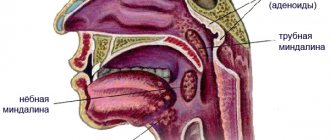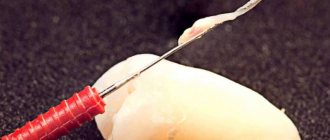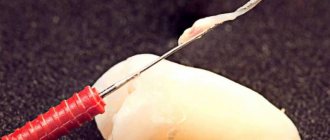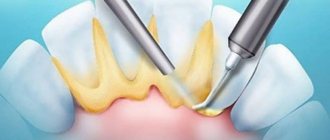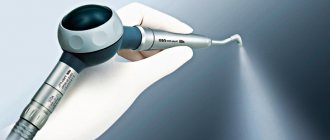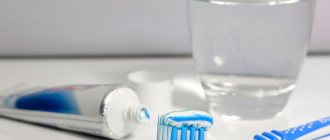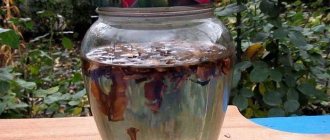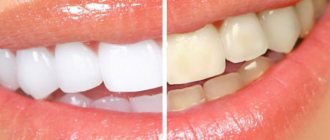Tartar occurs in 85% of people. It is formed due to the influence of 90 types of various microorganisms that penetrate the oral cavity. The resulting plaque remains on the tooth enamel and hardens, which leads to an acceleration of the process of tooth decay. In the article you can learn how to remove tartar quickly and efficiently.
Causes of tartar formation
Tartar formation
Plaque that accumulates on tooth enamel over time turns into a solid mineral deposit, which is difficult to remove without using special actions. 90% of plaque gets on the teeth after eating - it is a thin film in which, in addition to food particles, various microorganisms are present.
The main reasons for the formation of tartar:
- Poor oral hygiene – untimely cleaning, lack of rinsing after meals, tea or coffee.
- Incorrectly performed brushing - if you use a toothbrush that is not suitable for the person or perform incorrect movements while brushing.
- Smoking (nicotine leaves characteristic dark marks on the enamel) – teeth become yellow.
- Excessive consumption of sweets - bacteria remain on the enamel
- Frequent consumption of tea, coffee, red juices.
- Passion for fatty foods.
- Alcoholic drinks - their consumption leaves a coating, which over time hardens and turns into stone.
- Pathologies associated with chewing processes.
- Lack of fresh fruits and vegetables on the menu.
- The predominance of soft food in the diet - food particles remain on the surface of the teeth, since the chewing process is practically not required.
- The use of low-quality toothpastes and rinses in the process of hygiene care.
- Diseases of internal organs.
- Violation of metabolic processes.
- Diseases associated with the gastrointestinal tract.
- Lack of beneficial microflora in the intestines.
- Poor nutrition.
It is also necessary to ensure that the body always has a balance of microelements and vitamins, since the lack of these components increases the growth of tartar.
Symptoms
Symptomatic manifestations of tartar:
- The appearance of dark circles and spots on the enamel.
- A characteristic manifestation is an unpleasant odor from the oral cavity (even after brushing).
- Redness of the gums.
- The appearance of a blue tint on the gums.
- The appearance of blood during brushing or mechanical impact on the gums (for example, while a person eats apples).
- Inflammatory processes in the oral cavity with itching and pain.
At the very beginning of its formation, tartar forms around the neck of the tooth. Visually, it looks like a yellow or brown rim. If no action is taken to eliminate it, the plaque will spread to the crown and then to the periodontal pocket.
Customer Reviews
Veronica: I often buy Dabur paste.
I like its smell and am attracted by the presence of natural ingredients in the composition. For me, the last quality is the most important, since not only my husband and I use the paste, but also our kids. Svetlana:
I've tried a lot of cleansers to clean my teeth. When tartar developed, the dentist advised me to use Albadent. And indeed, it saved me from an unpleasant problem and gave me fresh breath throughout the day. I am very pleased with my choice and now I only buy Albadent.
Angelina: I really like using Detartrin paste. I am satisfied with almost everything about it - composition, price, health safety. The paste clears plaque on enamel, strengthens my gums and eliminates the problem of bleeding gums.
Kinds
Experts distinguish the following types of pathological process:
- Supragingival - the consistency of the stone resembles clay. The expression on the enamel is clear. Removal is easy if you contact your dentist without delaying treatment.
- Subgingival - visually it cannot be recognized at home. You can find out about the problem by incising the gums in the dental office. The formations are dense and hard if you touch it.
- Loose.
- Hardened.
Important! The problem of tartar formation cannot be left without medical (dental) control. If you do not start the removal process on time, inflammation will occur with further formation of caries and damage to the oral mucosa.
It must be remembered that bacteria form under tartar, which constantly release toxins. They then begin to penetrate the blood, with the current of which negative substances spread throughout the body. These substances contribute to the exacerbation of various chronic diseases present in humans.
How to remove tartar in dentistry
Reading techniques in a dental office:
| Process name | Description | Price |
| Mechanical cleaning | It is a traditional form of getting rid of hardened plaque in dentistry. It is performed using a special tool - a drill. Rotation removes deposits from the enamel, and the surface is additionally polished. Feature: you can remove deposits that are superficial. There is discomfort during removal. | On average 200 rubles per 1 tooth. |
| Ultrasonic cleaning | Cleaning using ultrasound can remove up to 90% of deposits. It is used even when stone has formed under the gums. Deposits are eliminated along with bacteria - complete disinfection of the oral cavity is carried out. Discomfort during the procedure may occur in places where the enamel is thinnest or damaged. To reduce pain before the procedure, the teeth are coated with a special dental composition, which will need to be thoroughly washed off at the end of exposure to the tartar. | The average cost of the procedure is 250 rubles per tooth. |
| Laser cleaning | The procedure is considered safe and gentle on enamel. The work is carried out without direct contact with the surface of the tooth or gum. The laser removes deposits layer by layer, transforming them into powder. The next stage is to wash away the remaining deposits with jets of water and air. The patient does not experience any unpleasant or painful sensations. In complex cases, 2-4 procedures are required. Additionally, enamel lightening is achieved, harmful microorganisms are removed, and the condition of the oral cavity is improved. | The average price of the procedure is 850-1100 rubles. |
| Dry cleaning | During the removal process, special compounds based on alkalis and acids are used. Tartar softens, after which the deposit is easily removed by rinsing the mouth. There is no discomfort or pain during the procedure. The compositions in 95% of cases have a pleasant taste. Feature: old deposits cannot be removed. There is a possibility of damage to the enamel or gums and tissues in the oral cavity. | The cost of the procedure is on average 1000 rubles per session. |
Mechanical cleaning Ultrasonic Laser Chemical
Important! Laser cleaning of teeth from deposits has a number of contraindications: age under 18 years, a large number of fillings or increased sensitivity of the enamel.
Grinding and polishing of enamel is also carried out. This procedure is carried out when the deposits on the surface are not old. The technique allows you to remove the smallest particles of stone remaining after the main procedure. The cost averages 250-300 rubles per 1 tooth.
How to get rid of tartar at home
Be careful not to damage the enamel!
Tartar in the initial stages of its formation can be removed at home. There are a number of traditional methods to clean it:
- Using hydrogen peroxide - you will need to dilute it with water (1:3), apply it to the enamel using a cotton pad. Leave for 2-3 minutes, rinse, repeat the procedure once a week.
- Table salt – soak your toothbrush in water, then dip it in the salt. Brush your teeth for 3 minutes, rinse your mouth well. The cleaning course is 2 weeks daily, after 14 days every other day.
- Baking soda – add water to create a paste-like consistency. The product is applied to the plaque, left for 3-4 minutes, and washed off.
- Natural honey needs to be diluted in warm water. The resulting composition should be rinsed once a week.
- Walnut - walnut bark is used, which needs to be crushed into powder. The resulting component must be diluted with water to the consistency of a decoction. Then rinse once a day for 3-5 minutes.
Decoctions of burdock, celandine, and oak root herbs help get rid of tartar at home, as well as remove possible inflammatory processes and other damage in the oral cavity.
Decoctions from plants to remove plaque
The best removal methods include folk remedies.
You can prepare a special decoction and other medicines to remove the stone yourself. For example, rinsing teeth with honey is popular. You will need to dissolve 1 spoon of the sweet product in a glass of water and rinse for 5 minutes every day. Sage decoction demonstrates effectiveness in dental treatment. You will need to take 1-3 tablespoons of the herb, pour a glass of hot water and leave for 15 minutes. Wait until the resulting broth cools down, then you need to rinse 3 times a day.
Tartar pastes
To maintain the achieved positive result, for preventive purposes it is necessary to use special toothpastes that contain special particles that can soften and remove deposits. The main ones:
- PRESIDENT White Plus.
- LACALUT White.
It is recommended to use them only after consultation with a specialist.
Special brushes
Brushes for cleaning teeth from tartar should be electric. There are 2 versions of the device:
- With built-in generator (removes deposits in easily accessible areas).
- With a rotating head (effective for removing stone from areas where a regular brush cannot reach).
The devices should also be used after consultation with a specialist.
How do you choose what to look at?
When choosing the best paste, you should take into account a number of factors, namely:
- Most toothpastes contain an abrasive substance that has a negative effect on the enamel surface.
safety of the components included in the composition;
- manufacturer reliability;
- product quality;
- reviews about the chosen product.
Not all toothpaste is safe.
Most of them contain an abrasive substance that has a negative effect on the enamel surface.
A good enamel cleaning paste usually includes:
- Fluorine (fluorides), which are useful components. Their level should be 0.1-0.6%.
- Calcium carbonate is an abrasive substance that effectively cleans the enamel surface of bactericidal deposits.
Important! The paste cannot contain both fluorine and calcium carbonate, since their combination will lead to the destruction of the enamel. - The RDA level allows you to find out the amount of abrasive in the composition. When choosing, you should take into account the sensitivity of the teeth and the intensity of the appearance of new deposits. The higher the RDA, the more effectively the paste will cope with crystallized deposits. However, with sensitive enamel, the RDA level should not exceed 25 units!
- SLS is the ingredient responsible for the degree of foaminess. It is a mistaken belief that the most effective product is the one that foams well. High-quality pastes do not contain SLS in their composition, as it is harmful to the body.
- Triclosan is an antibacterial substance that can act as an antibiotic. This drug destroys harmful bacteria along with beneficial substances. In this situation, the microflora of the oral cavity suffers, which leads to the occurrence of various diseases.
Preventive measures
Hygienic procedures are required to be carried out 2 times a day. Cleaning is carried out on the inside and outside of the teeth. Additionally, after each meal you need to use dental floss or irrigator. A rinse aid with a disinfectant effect helps reduce the likelihood of deposits forming.
.
Global White
"Global White" also has a whitening effect and is excellent for everyday use. It perfectly removes stains and plaque from the enamel surface without injuring or scratching the enamel itself. Systematic use of Global White will not only help get rid of plaque, but also prevent the formation of stone. The silica granules included in the composition gently polish the teeth, making them white and shiny. In addition, this paste contains pyrophosphate and fluoride, strengthening the enamel.
Popular questions
- Is it painful to remove tartar? – it all depends on the technique used and the individual characteristics of the body. In 90% of cases there is no pain.
- Does it need to be removed? – the removal process is mandatory, since the stone leads to the destruction of tooth enamel, caries, and inflammatory processes on the gums and tissues.
- Is it possible to remove it with an irrigator? – at the initial stages of sediment formation.
- Which doctor removes tartar? – Periodontist.
- How to remove tartar from a child? – you need to visit a doctor who will perform a procedure to remove soft deposits on the enamel.
- Is it possible to completely remove tartar on your own? – if the problem is at an early stage, only specialists can remove the neglected stone.
- How to soften it and dissolve it before cleaning at home? – use special herbal decoctions, use lemon juice, which is applied to the damaged area with a cotton pad for 2-3 minutes before the main cleaning.
- How to remove it from dentures? – It is necessary to dilute the vinegar with water (1:1), then place the denture in the liquid for 15 minutes, then clean with a regular brush for 2-3 minutes. The procedure is carried out daily.
- How often can you remove tartar? – The frequency of the procedure depends on the chosen technique and the severity of the condition.
- Can I use kerosene? – this method is not recommended, as it can cause harm to health.
The rest of the recommendations will be given by the doctor after an individual consultation.

